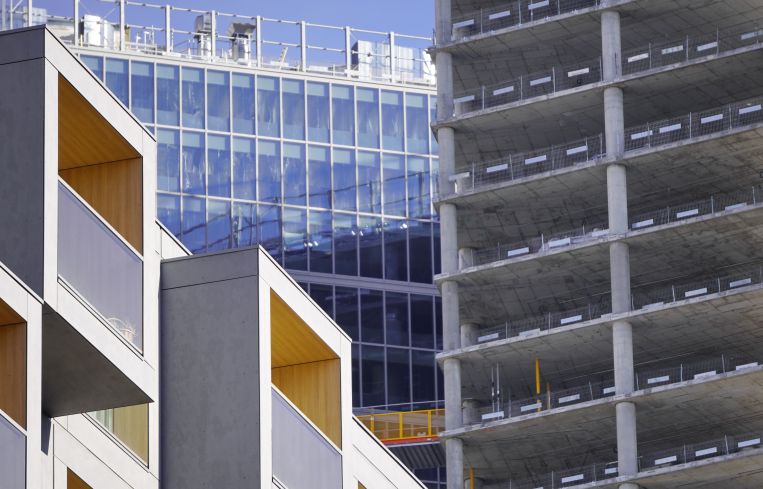Presented By: JPMorgan Chase
JPMorgan Chase Continues Its Effort to Finance New York Affordable Housing
By JPMorgan Chase October 24, 2022 9:00 am
reprints
As the nation’s housing shortage shows no signs of abating, various companies and municipalities are working together to create affordable housing for all. Partner Insights spoke with James Whelan, executive director of Real Estate Banking at JPMorgan Chase, about the firm’s ongoing contributions to close the housing gap in New York.
Commercial Observer: How is JPMorgan Chase assisting in the creation of mixed-income housing in New York, including apartments affordable to people making a small percentage of the area median income (AMI)?
James Whelan: JPMorgan Chase has actively supported the development and preservation of affordable apartments for more than 20 years, and we’re investing more in this space now than ever before. Our Community Development Banking (CDB) group is dedicated to providing financial solutions to community development organizations that invest in the development of affordable housing projects in low- and moderate-income communities. CDB has more than tripled its originations over the past decade.
In Real Estate Banking, we have actively invested in affordable housing developments primarily through the financing of large-scale multifamily projects supported by the 421a real estate property tax law. Developments benefitting from the 421a program require that 20 to 30 percent of the units developed be reserved as affordable. Per the Real Estate Board of New York, 56 percent of the city’s multifamily units created in the past eight years involved 421a, and 28 percent of all affordable units were subsidized by 421a, so it was a major driver of both market-rate and affordable unit creation. JPMorgan Chase also actively invests in affordable housing development and preservation through Historic Tax Credit equity investments and Capital Solutions.

How does this fit in with the other efforts within the company to help spearhead affordable housing?
In October 2020, JPMorgan Chase committed $30 billion to help advance racial equity, including $14 billion earmarked to preserve affordable housing across the U.S. As a leader in the commercial real estate financing space, we have focused on leveraging our expertise to help drive a more inclusive economy. To that end, our Commercial Term Lending business launched the Mandated Affordable Program, which offers discounts to owners whose properties have regulated agreements with government agencies to maintain affordable rents.
Through the end of 2021, the firm has approved the funding of $13 billion, nearly exceeding the five-year goal of $14 billion in 15 months.
Who are some of the local partners working with JPMorgan Chase on this?
In addition to working with hundreds of clients whose projects we’re financing, JPMorgan Chase works with the New York City Department of Housing Preservation and Development, the NYC Housing Development Corporation, and New York State Homes and Community Renewal.
Over the last few years, we have seen so many new and significant entrants into the affordable housing space. Developers, private equity firms, investors and financial institutions are allocating more of their capital to this subset of the real estate industry, which will help to reduce investment hurdle requirements and will, in turn, improve the feasibility of affordable housing development projects.
Can you provide a few examples of projects?
Our Real Estate Banking group was the administrative agent and lead lender on a $125 million construction loan to finance the development of a 394-unit building in the Hunter’s Point South neighborhood in New York City. One hundred eighty-five units (47 percent) were rent-restricted affordable units. Eighty of those were restricted to households earning less than 50 percent of AMI.
We were also one of the lead lenders on the construction loan for the adjacent property with the same developer. That loan totaled $262 million, and two-thirds (533) of the 800 units were AMI-restricted. One hundred sixty of 533 affordable units were reserved for those making 40 to 50 percent of AMI, and the remaining 374 affordable units were reserved for moderate-income renters. Both of these projects have been completed and are currently leasing, delivering much-needed affordable housing inventory to New York City at a crucial time.
What’s your role in all this?
As a senior client executive in our Real Estate Banking group, my job is to deliver commercial real estate products and services to our institutional clients in the industry. Providing construction loans on multifamily development projects is an important piece of that. Most large-scale multifamily projects delivered over the past decade included affordable housing due to the strength and benefits of the 421a program. Additionally, I work closely with the Community Development Banking, Commercial Term Lending and Tax Credit equity teams to ensure my clients are taking advantage of all the firm has to offer.
How much has JPMorgan Chase spent on these development efforts so far, and how much housing has been created?
In addition to the $13 billion invested to support the preservation of over 100,000 affordable units, we’ve devoted over $10 billion over the past five years in the development of new affordable housing, resulting in the creation of more than 62,000 units.
What’s JPMorgan Chase’s overall goal?
At JPMorgan Chase, we strive to be a catalyst of change in the hopes of ending the housing crisis and recognize housing affordability requires national attention. It’s important we keep talking about it and taking action. Progress on this issue requires that local, state and national government agencies and private market participants work together to achieve impactful results. This isn’t a short-term problem. It’s a structural problem for our country, and we’re committed to being part of a long-term solution.



